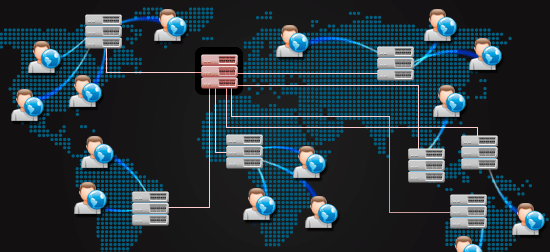|
|
|
|
In this edition of Views and News, we explore the new "share everything" wireless pricing scheme announced by Verizon Wireless. We also examine the rising trend of major web-based companies deploying their own vertically-integrated Content Delivery Networks, and the competitive concerns raised by this integration.
Read on below, or navigate over to
econtech.com
where you can read online, or download a
printer-friendly version.
|
|
Verizon launches "Share Everything" wireless pricing plans
|
|
 Share Everything, the new rate plan structure announced by Verizon Wireless, represents the largest business model innovation in the wireless industry in recent memory. Not since AT&T Wireless announced its Digital One Rate calling plans in 1998 has there been such a major shakeup in wireless pricing. Touting its new plans as revolutionary – "[they] will forever change the way customers purchase wireless services" – Verizon announced its new "Share Everything" plans on June 12, 2012. The Share Everything plan puts every customer into an unlimited voice minutes and unlimited text, picture and video messaging bundle. The plans, designed to be shared with multiple devices similar to family plans, also provide a single allowance of data to be shared by as many as 10 wireless devices on the same account.
Share Everything, the new rate plan structure announced by Verizon Wireless, represents the largest business model innovation in the wireless industry in recent memory. Not since AT&T Wireless announced its Digital One Rate calling plans in 1998 has there been such a major shakeup in wireless pricing. Touting its new plans as revolutionary – "[they] will forever change the way customers purchase wireless services" – Verizon announced its new "Share Everything" plans on June 12, 2012. The Share Everything plan puts every customer into an unlimited voice minutes and unlimited text, picture and video messaging bundle. The plans, designed to be shared with multiple devices similar to family plans, also provide a single allowance of data to be shared by as many as 10 wireless devices on the same account.
The new plan becomes available on June 28, 2012 and is mandatory for all new subscribers. Existing Verizon customers may adopt the new plan without a contract extension, or may remain on their legacy plans, at least for now. Some existing customers will be able to save money by making the switch, while others that are low volume voice/text users will be better off by staying on their current plan. Verizon has also made it clear that it does not want customers to remain on its legacy unlimited data plans. Those customers that keep the unlimited data plans will no longer be eligible for "new every two" subsidized handsets.
Continue reading at econtech.com
|
|
Netflix, Google bring content to the network edge
|
|
 Caching content at the network edge close to the end user is not a new concept. Content Delivery Networks (CDNs) such as Akamai and SAAVIS have been providing such services since the late 1990s. What is new is that several major web-based companies are taking this service in-house, and collocating their own servers at ISP-owned facilities. CDNs have long been a win-win for website owners and ISPs, speeding up delivery of web content while reducing traffic on Internet backbone networks. Now individual web companies are striking deals directly with ISPs and installing their own servers at ISP locations.
Caching content at the network edge close to the end user is not a new concept. Content Delivery Networks (CDNs) such as Akamai and SAAVIS have been providing such services since the late 1990s. What is new is that several major web-based companies are taking this service in-house, and collocating their own servers at ISP-owned facilities. CDNs have long been a win-win for website owners and ISPs, speeding up delivery of web content while reducing traffic on Internet backbone networks. Now individual web companies are striking deals directly with ISPs and installing their own servers at ISP locations.
Continue reading at econtech.com
|
|
|
|
About ETI. Founded in 1972, Economics and Technology, Inc. is a leading research and consulting firm specializing in telecommunications regulation and policy, litigation support, taxation, service procurement, and negotiation. ETI serves a wide range of telecom industry stakeholders in the US and abroad, including telecommunications carriers, attorneys and their clients, consumer advocates, state and local governments, regulatory agencies, and large corporate, institutional and government purchasers of telecom services. |
|
|
|
|